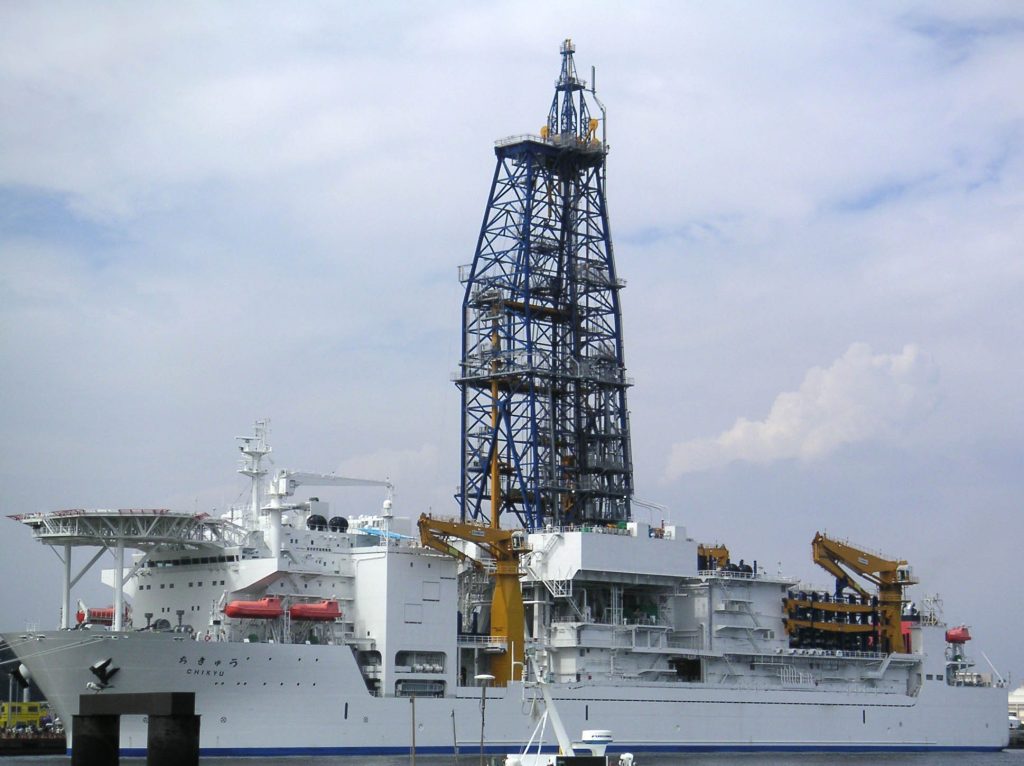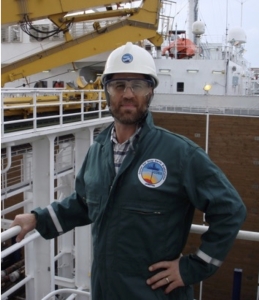3.5 Chikyū

Chikyū is currently the largest scientific drilling vessel. Built in 2005, what makes Chikyū different from other drilling vessels is its ability to drill 7,000 meters below the seafloor through its riser drilling technology. The Japan Agency for Marine-Earth Science and Technology (JAMSTEC) owns Chikyū, with the ship operated by its Centre for Deep Earth Research (CDEX). Chikyū’s mission includes:
- Understanding marine disasters
- Elucidating the global climate and ocean changes
- Understanding the subseafloor biosphere
Riser Drilling Technology
What is a riser drilling system? View this video to learn how the drilling process is carried out deep below the seafloor.
Exercise – A Quick Check on Your Knowledge of “Riser Drilling”
Respond to these questions to help you think through how a riser drilling system operates:
a) Why is drilling mud used instead of seawater in a riser drilling system? What are the advantages?
b) Why is drilling mud reused? How is used drilling mud collected?
c) What is done to ensure a drilled hole does not collapse?
To continue to understand the full drilling process of Chikyū, check out this video.
As part of the Integrated Ocean Drilling Program (IODP, 2003-2013) and International Ocean Discovery Program (IODP, 2013-2024), Chikyū completed 18 expeditions (through EXP 380), visiting 44 sites and recovering 5,978 meters of core material. The deepest water depth Chikyū has drilled as part of IODP was 6,929 m, and its deepest hole penetrated was 3,059 m.
SciOD Spotlight – The Boarding Process with Jon Lewis

Before scientists are allowed to board Chikyū, there is mandatory safety training that must be completed. Jon Lewis sailed on Expedition 315, which required him to board the ship from helicopter on to the ship’s helipad. Take a listen to Jon describing what was involved, and why he thought he might not pass the training.
There is a video online to view the HUET Helicopter escape training Jon and all others that sail on Chikyū must complete.
Although the majority of us will never have the opportunity to step foot on Chikyū (or land on Chikyū, as Jon did), you can come very close to a model of the ship. If you find yourself one day visiting Washington DC, enter the Sant Ocean Hall at the Smithsonian Institution National Museum of Natural History. Here, you will see a 1:100 scale model of Chikyū and be able to learn more about scientific ocean drilling as well as what we can learn from deep-sea mud and sediment.
Gallery of images in the Sant Ocean Hall of the Smithsonian’s Natural History Museum. (Credit: L. Guertin, CC BY-NC 4.0).
Exercise: Learn About a Chikyū Expedition!
This four-part video series (~30 minutes total) follows Expedition 365: Exploring the Fault Trace, which sailed from March 26 to April 27, 2016.
As you watch, reflect on and respond to the following questions. Note that some answers may appear in different sections of the video:
a) What were the main scientific objectives of this expedition? Why was Chikyū positioned at the Nankai Trough?
b) Microbiologists were part of this expedition. What were scientists hoping to learn about the subsurface biosphere, and how did Chikyū help them collect the necessary materials?
c) What technologies were used to achieve the scientific goals of the expedition?
d) What kinds of information can be gathered from long-term borehole monitoring systems?
e) How might the results of this research benefit society—both in Japan and around the world?
f) Identify up to three moments in the video when you experienced an “ah-ha” or “wow” moment. What made these parts stand out to you?

